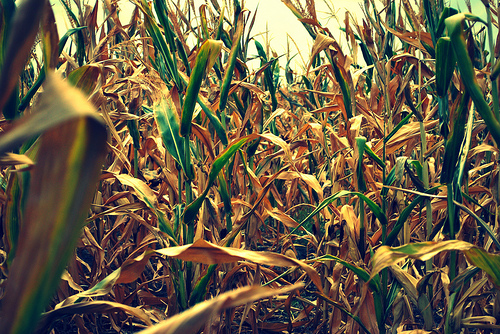
Photo by Claire-Marie Harris.
What do you say to a corn stalk ravaged by a heat wave?
Nothing. Its ears are stunted.
Corn growers throughout the Midwest this summer are facing an extraordinary ordeal that climate scientists have predicted could become the new ordinary. This year’s growing season has been consistently dry and warm, leading to stunted stalk growth, and many of the corn-growing states are now sweltering through record-breaking heat during a critical stage of kernel development with nary a storm in sight.
As The New York Times reported this week, “the sweltering temperatures and a lack of rain are threatening what had been expected to be the nation’s largest corn crop in generations.” The business journalists — whose audience is those who gamble on corn’s futures — have also been reporting the story.
“About 50 percent of the corn-producing area of the Midwest is running significant moisture shortages,” says David Streit, an agricultural meteorologist and founder of Commodity Weather Group, which advises clients in the farming and energy sectors.
That’s a problem, because the plants have entered their pollination phase. That’s the “very critical time,” Streit says, when corn silks are pollinated and begin to grow into juicy kernels. But without water, growers are left with little more on their stalks than withering husks.
“When you have that kind of heat at this critical pollination period,” he adds, “you can lose several bushels an acre per day.”
Climatologists expect this summer’s hot and dry conditions to occur more frequently as the planet heats up. Inland areas, including the Midwest and other farming regions of the world, are expected to receive more than their fair share of temperature spikes.
“You have relatively moderate global warming, but it creates greater warming over land than over the oceans,” said Noah Diffenbaugh, a climate specialist at Stanford University’s Woods Institute for the Environment.
Diffenbaugh recently co-authored research in the journal Nature Climate Change that revealed that climate change will substantially increase the volatility of corn prices over the coming decades.
“The number of negative yield years increases substantially, even with just 1 degree C of global warming,” Diffenbaugh said.
Paul Bertels, an Illinois corn grower and vice president at the National Corn Growers Association, was downbeat on Monday when discussing this year’s expected harvest. But he characterized the hot dry spell as a “normal event” and said he is not convinced that the weather will change as much as Diffenbaugh and others predict it will.
Not that Bertels wants to downplay the reality of drought. “We’ve had bad droughts here before,” he says. “Eighty-eight was probably the last really significant drought that was Midwest-wide. My grandma will talk about 1934 and 1936 being really bad summers. So it’s not unprecedented, but people’s memories tend to be shorter.”
To help manage growing rainfall shortages, farmers are increasingly installing irrigation systems rather than relying on rainfall. But irrigation places additional burdens on the Ogallala Aquifer, as well as the rivers and streams in the area.
Meanwhile, Monsanto is testing DroughtGard on 10,000 acres across the Midwest. The genetically modified crop was panned last month by the Union of Concerned Scientists (UCS), which found that the product was only marginally effective in withstanding dry weather. A press release from the group reads:
DroughtGard — the only crop engineered for drought tolerance approved for commercial use — reduced crop losses by about 6 percent. By comparison, breeding and improved farming practices have increased drought tolerance by roughly 1 percent per year over the past several decades.
There’s also the fact that DroughtGard seeds work best during moderate droughts, despite the fact that climate change is expected to bring more severe water shortages to corn-growing regions, the UCS reported.
The larger problem, say some experts, is the fact that so much of what we grow in the Midwest today are monocrops.
Crops of yesteryear were diverse (many foods were produced on one farm) and the varieties farmers planted often had generations to adapt to each local climate. Today, however, the sweeping plains of the Midwest are dominated by just a few strains of corn, soy, and wheat. The genetically modified DNA of much of the corn being planted across the nation is virtually identical. That leaves farms and farmers especially vulnerable to changing weather patterns.
“Corporate control of agriculture has really driven a kind of one-size-fits-all production,” said Patrick Woodall, research director at the nonprofit Food and Water Watch. “That obviously means a system that’s not very resilient.”
Woodall said the U.S. Department of Agriculture (USDA) should fund more research to help farmers transition to a broader diversity of “climate appropriate crops” — those that are better-suited to their local climates. He added: “This is going to require a lot of very intense thinking on the part of the USDA, farmers, agribusiness — and also on the part of consumers.”



